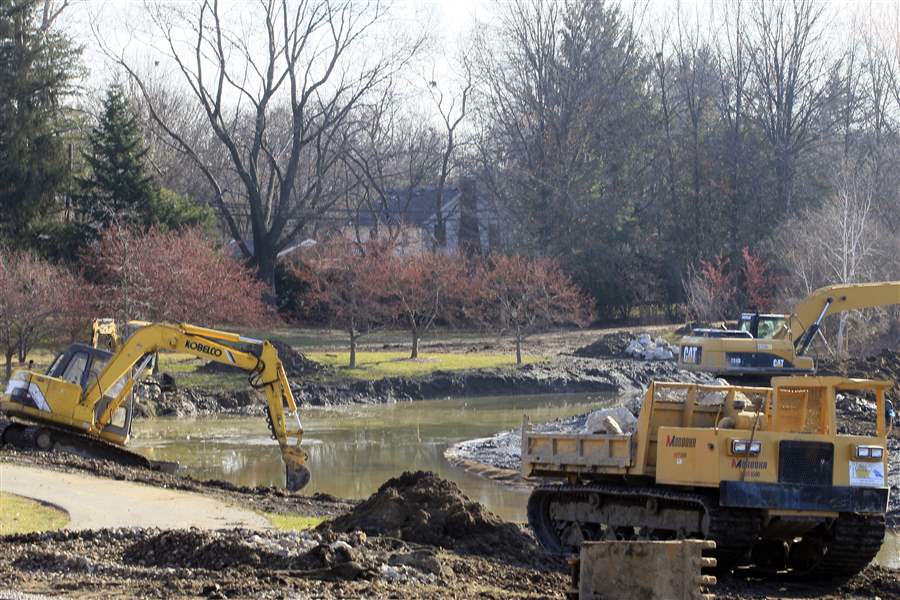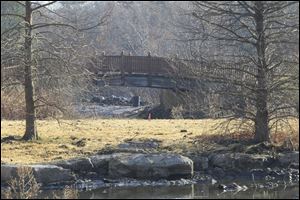
$1.1M project at Toledo Botanical Garden includes dredging, removal of 2 dams to revitalize channel
12/28/2012
The Toledo Botanical Garden is dredging Crosby Lakes, the two artificial lakes in the garden, as part of the restoration project.
The Blade/Jetta Fraser
Buy This Image

The Toledo Botanical Garden is dredging Crosby Lakes, the two artificial lakes in the garden, as part of the restoration project.
The Toledo Botanical Garden is in the middle of a major overhaul, a project that features removing two dams and restoring a natural stream channel that runs through the 60-acre public garden.
Hill Ditch, an Ottawa River tributary, runs west to east through the grounds. In 1988, two dams were installed to create water features in the garden.
Roughly 28,000 cubic yards of sediment has built up in the man-made Crosby Lakes since then, botanical garden officials said, impairing water quality and fish habitat and creating islands where invasive plants took root.
The water depth reduced from 14 feet in some places to about 6 feet, and in other areas dropped from 8 feet to half a foot. Banks eroded, carp invaded, and the wide-open site attracted Canada geese, said botanical garden superintendent Josh Miller.
This fall, work began to remove the dams and restore the stream’s natural channel.
“The stream has been re-established, and there’s basically a lot of rock structures in place that keep the flow of the stream in the middle of the channel,” Mr. Miller said.
The Ohio Environmental Protection Agency provided a $500,000 federally funded grant, which the botanical garden will match through in-kind services and other funds to pay for the $1.1 million project, he said.
Orange construction fencing winds across the snowy grounds, located between Elmer Drive and West Bancroft Street in West Toledo, and provides a splash of color in the wintry black-and-white garden landscape.
The project has required some temporary pathway closings, but access will be restored when heavy construction work is completed by early spring, Mr. Miller said. A major planting effort, involving volunteers, will begin in April.
The result will be a stream about 15 feet wide in most places with a lake in the property’s central portion, in roughly the same footprint as Crosby Lakes, fed through a flow structure that fills the lake in high-flow periods and also feeds it with groundwater and natural runoff, Mr. Miller said.
The stream’s banks will be planted with native species that provide longer flowering periods and that provide food for such wildlife as birds, amphibians, and reptiles. Bridges built over the dams will remain.
Dale Theis, president of the botanical garden’s board of trustees, said the project “revitalizes” what was, in essence, a “dead” lake.
“It was not a resource that attracted people down to the water, and with the redesign ... it really enhances the whole center portion of the gardens and allows people to interact with water,” he said.

The watercourse improvements at the Toledo Botanical Garden are both aesthetic and ecological.
Officials chose to do the current work in the winter, when fewer people explore the grounds. The watercourse improvements are both aesthetic and ecological, Mr. Theis said.
“Because of the bank erosion, you couldn’t get close to it, and because the water was stagnant, you didn’t want to get close to it,” he said.
Construction of the ponds and related gardens cost about $1.75 million and was paid for with state and city funds and private donations. Not as much was known a quarter-century ago about how the dams would affect the area, Mr. Miller said, and without regular dredging, the sediment problem “spiraled out of control.”
Ohio EPA spokesman Dina Pierce said the grant targets water quality improvement. Removing dams restores “a free-flowing stream,” which makes for a healthier, less-stagnant stream.
“It is good when you can get dams out. That’s not always possible ... but where possible, we do encourage that because it’s definitely better for the habitat,” she said.
Contact Vanessa McCray at: vmccray@theblade.com or 419-724-6065.